Jun 25, 2025
Valve pressure testing is a critical process in ensuring the reliability, safety, and performance of valves used in various industries. Proper pressure testing verifies that valves can withstand the operational pressures and environmental conditions they will encounter during service. To maintain consistency and reliability, several standards and practices guide valve pressure testing. This article explores these common standards while highlighting the roles of modern equipment, such as the Smart Valve Test Platform and the Valve Body Test Bench, in meeting testing requirements.

Importance of Valve Pressure Testing Standards
Valve pressure testing involves subjecting a valve to controlled pressure conditions to evaluate its integrity, sealing ability, and strength. Without standardized procedures, the testing results may vary widely, pilot to potential safety risks or equipment failures in the field. Standards provide guidelines on how to conduct pressure tests, including the types of tests, pressure levels, durations, and acceptance criteria.
Following standardized procedures helps manufacturers, inspectors, and end-users communicate clearly about valve quality and ensures compliance with regulatory requirements. Some of the widely recognized international standards that address valve pressure testing include API 598, ISO 5208, and ASME B16.34. These standards outline the methodology for pressure testing, leak detection, and documentation.
Key Valve Pressure Testing Procedures
The two primary types of valve pressure tests are the hydrostatic test and the pneumatic test.
Hydrostatic Testing: This test involves filling the valve with water or another incompressible fluid and increasing the pressure to a specified test level. It checks for leakage and structural strength. Hydrostatic testing is preferred due to its safety, as water is incompressible and will not cause violent reactions if the valve fails.
Pneumatic Testing: This test uses compressed air or gas to pressurize the valve. It is generally conducted at lower pressures than hydrostatic tests due to safety concerns. Pneumatic testing is more sensitive in detecting leaks but requires careful handling.
Both testing methods are guided by standards specifying pressure levels relative to the valve's rated pressure, test duration, and acceptable leakage limits.
Role of the Smart Valve Test Platform
The development of modern testing equipment has significantly improved the accuracy and efficiency of valve pressure testing. The Smart Valve Test Platform represents an advanced solution integrating automation, data acquisition, and real-time analysis into the testing process.
This platform allows operators to set test parameters precisely and monitor pressure changes, leak rates, and other critical indicators with high sensitivity. The smart system stores test data automatically, providing comprehensive records for quality control and traceability.
Furthermore, the Smart Valve Test Platform often includes safety features such as automatic pressure relief and emergency shutdowns, less risks during testing. The digital interface enables remote control and integration with quality management systems, which helps streamline production workflows and improve testing consistency.
Functionality of the Valve Body Test Bench
Another essential piece of equipment in valve pressure testing is the Valve Body Test Bench. This bench is designed specifically to hold and secure the valve body during pressure testing. It provides a stable platform for applying hydraulic or pneumatic pressure uniformly across the valve.
The Valve Body Test Bench accommodates different valve sizes and types, ensuring the testing is conducted in a controlled environment. It often includes fixtures and clamps to prevent valve movement, which could affect test accuracy.
The bench is also equipped with pressure gauges, sensors, and valves to regulate and monitor the test medium. Combined with a Smart Valve Test Platform, the test bench forms a complete testing station that meets the demands of modern valve manufacturing and quality assurance processes.
Common Standards Referenced in Testing
API 598: The American Petroleum Institute's standard for valve inspection and testing covers pressure testing requirements for valve bodies and seats. It defines test pressures, leakage rates, and test methods.
ISO 5208: This international standard specifies pressure testing requirements for metallic valves, including test pressures for shell and seat tests, test durations, and permissible leakage rates.
ASME B16.34: The American Society of Mechanical Engineers standard covers valves' design and construction, including testing requirements to ensure mechanical integrity.
Adhering to these standards helps maintain uniformity across valve manufacturers and ensures valves meet industry safety and performance expectations.
Valve pressure testing is a vital step in ensuring the safety and functionality of valves used in industrial systems. By following common standards such as API 598 and ISO 5208, manufacturers can perform consistent and reliable tests. The integration of modern equipment like the Smart Valve Test Platform and the Valve Body Test Bench enhances test accuracy, safety, and data management. These tools facilitate efficient and controlled testing environments, contributing to the production of valves that comply with stringent quality requirements. Through adherence to standards and use of advanced testing equipment, the valve industry continues to improve its capability to deliver reliable components for critical applications.